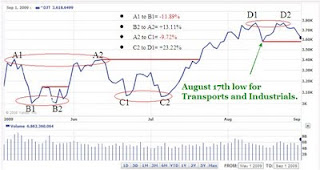“In the same editorial (Wall Street Journal, 1/4/1902) Dow goes on to give a useful definition from which legitimate inferences may drawn. He says: ...
‘It is a bull period as long as the average of one high point exceeds that of previous high points. It is a bear period when the low point becomes lower than the previous low points. It is often difficult to judge whether the end of an advance has come because the movement of prices is that which would occur if the main tendency had changed. Yet, it may only be an unusually pronounced secondary movement.’
This passage contains, by implication, both the idea of ‘double tops’ and ‘double bottoms’ (which I frankly confess I have not found essential or greatly useful) and the idea of a ‘line,’ as shown in the narrow fluctuation of the averages over a recognized period, necessarily one either of accumulation or distribution.”
Hamilton, William Peter. Stock Market Barometer. Harper and Brothers. 1922. page 32.
In my May 15, 2009 article, I pointed out how important double tops and double bottoms have played a role in defining the direction of the Industrials and Transports. So important is the role of double tops and double bottoms that they have accounted for 72% of the major bull and bear moves in the stock market. The current market action, since May 1st, has been in favor of double tops and bottoms in the Transports index portending the change in the market direction in the intermediate term.
As you can see from the chart below, there have been two double tops and two double bottoms. So far, both double bottoms (B and C) and one double top (A) have been followed by sizable moves in the Transportation and Industrial index.
 Currently, we're faced with the double top indicated as D1 and D2. From what I can tell, if the decline from D2 goes any further below the August 17th low then we may retrace up to 75% of the gains from C2 to D1. This assessment is based on the prior correction of A2 to C1 from the rise of B2 to A2. On the way down to C2 there are smaller support levels however their significance is not as pronounced as the percentage change from A2 to C1. We should assume the worst case scenario and expect that the Transports will go to 3239.36. Falling to points C1 and B1 would be the next order of operation.
Currently, we're faced with the double top indicated as D1 and D2. From what I can tell, if the decline from D2 goes any further below the August 17th low then we may retrace up to 75% of the gains from C2 to D1. This assessment is based on the prior correction of A2 to C1 from the rise of B2 to A2. On the way down to C2 there are smaller support levels however their significance is not as pronounced as the percentage change from A2 to C1. We should assume the worst case scenario and expect that the Transports will go to 3239.36. Falling to points C1 and B1 would be the next order of operation.
Interestingly, Charles H. Dow says that the action of double tops and double bottoms is most commonly associated with market manipulation. In Hamilton's Stock Market Barometer there is a July 20, 1901 Wall Street Journal excerpt where Dow says:
"Another method [for detecting manipulation] is what is called the theory of double tops. Records of trading show that in many cases when a stock reaches top it will have a moderate decline and then go back again to near the highest figures. If after such a move, the price again recedes, it is liable to decline some distance."
Hamilton, William Peter. Stock Market Barometer. Harper and Brothers. 1922. page 36.
The method described by Dow is commonly executed by institutions and other large money interests. The term that is most often used today is called a trial balloon. If successful, the money interests can gauge small investors willingness to sell or buy stocks and then execute a bull or bear raid. Today, it would seem unheard of for the editor of the Wall Street Journal to suggest there is manipulation and then go so far as tell how to detect it. And yet, the words of Charles H. Dow ring true today as they did in early 1900.
Note: On August 25th I said that the great Dow Theorist Richard Russell was wrong about his call of a new or renewed bull market. Well, after placing a call to Russell and talking to his staff the bull market indication was taken away the very next day and a non-confirmation was iterated. I'm sure that Mr. Russell got many calls on that error so I don't think that I swayed him personally (though I'd love to think that I did.)
My goal wasn't to have the bull market indication taken away, instead it was to demonstrate that a non-confirmation needed to be worked through. For this reason I still stand by my belief that the bullish move (within the context of secular bear market) from the March 9th low isn't over unless we resolutely pierce the 8146 level on the Dow Industrials. Touc.
Please revisit Dividend Inc. for editing and revisions to this post.
